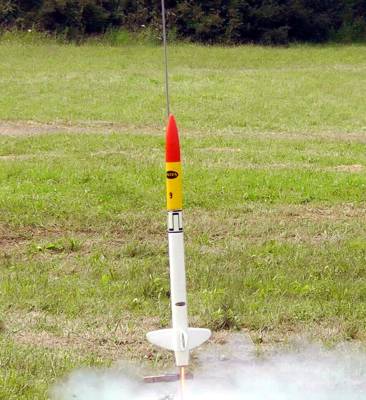The Sprint: This Astron Sprint is from the original '70s kit. It uses streamer recovery, but I changed it out for a small 8" parachute. It is designed for high-performance altitude flights, and generally requires longer-burning ejection delays for maximum height. The engine must be tape-friction-fit as this model does not have a metal motor clip. Instead it has the boattail end designed to reduce drag. This rocket was later given my "Iris" modification, which extends the body tube about 5 inches above the streamer/parachute bay, and allows for a payload with an Altimeter One to measure altitudes.
After this payload section was tragically lost when the screw-eye/balsa joint failed, I built a newer, lighter and smaller payload section. It is now 3-1/8" vs. 4-1/2", and weighs 9.8 grams. I certianly hope now I can get that extra 12 inches of altitude out of this bird and finally crack that elusive 1200 foot mark!
Originally, I replaced the flimsy crepe paper streamer with plastic one, but the plastic seems to stick to body tube because of static electricity, so I replaced it again with a small 8" parachute. With this parachute it descends at about 9 mph, soft enough for a safe grass landing. The rather small size should prevent this from drifting too much - a real problem considering the height it can attain. (The Iris altimeter payload is named after the Greek god of the rainbow. She is a messenger of the gods, linking the gods with humanity.) This rocket has flown higher than the NY Times Building in NY, the John Hancock Tower, and the Aon Center in Chicago.
| Flight Date: | 2013-06-30 |
| Rocket Name: | Sprint |
| Kit Name: | Estes - Sprint {Kit} (1249) [1970-1983] |
| Flyer's Name: | Rich DeAngelis |
| Motors: | A8-3 |
| Expected Altitude: | 164 Feet |
| Wind Speed: | 4.00 mph |
| Launch Site: | Fort Indiantown Gap, PA |
| Actual Altitude: | 168 Feet |
Last flight of the day, it is getting entirely too hot. Rounding out the motor mix, this time I went with the smaller A8. Knowing there was no rush getting the Sprint back to earth, I selected a rather large 13.5” parachute for this flight.
The A8 pushed the Sprint skyward with an acceleration of 14.4 Gs, while sustaining 5.3 Gs for the ½ second burn. This propelled the rocket to 59 mph (the slowest ever recorded), followed by a three second coast. The delay was right on schedule at 3 seconds, but this was not enough for the high-performance Sprint. The ejection fired at 160 feet, but the rocket continued to gain an additional 8 feet to reach an apogee of 168 feet just 2/10ths of a second later.
The large parachute slowed the rocket’s return to a predictably slowest-ever speed of 7 mph. Flight time was 17.5 seconds. They should all fly this well, Sprint gave me three perfect flights today. After that, the club started packing up. Almost on cue, seconds after the equipment was all stowed, a deluge of rain struck.
These three flights showcased my new strategy of changing out parachutes and selecting the size based on the predicted altitude. I no longer store a single, dedicated chute for each rocket. Instead I have a partitioned file folder with a selection of 80 parachutes to choose from in a variety of styles. This storage method keeps the chutes flat and wrinkle free, unlike storing them all crumpled up in the rocket’s body tubes.
| Stage | Motor(s) |
|---|---|
| 1 | Estes A8-3 |
 |
 |

